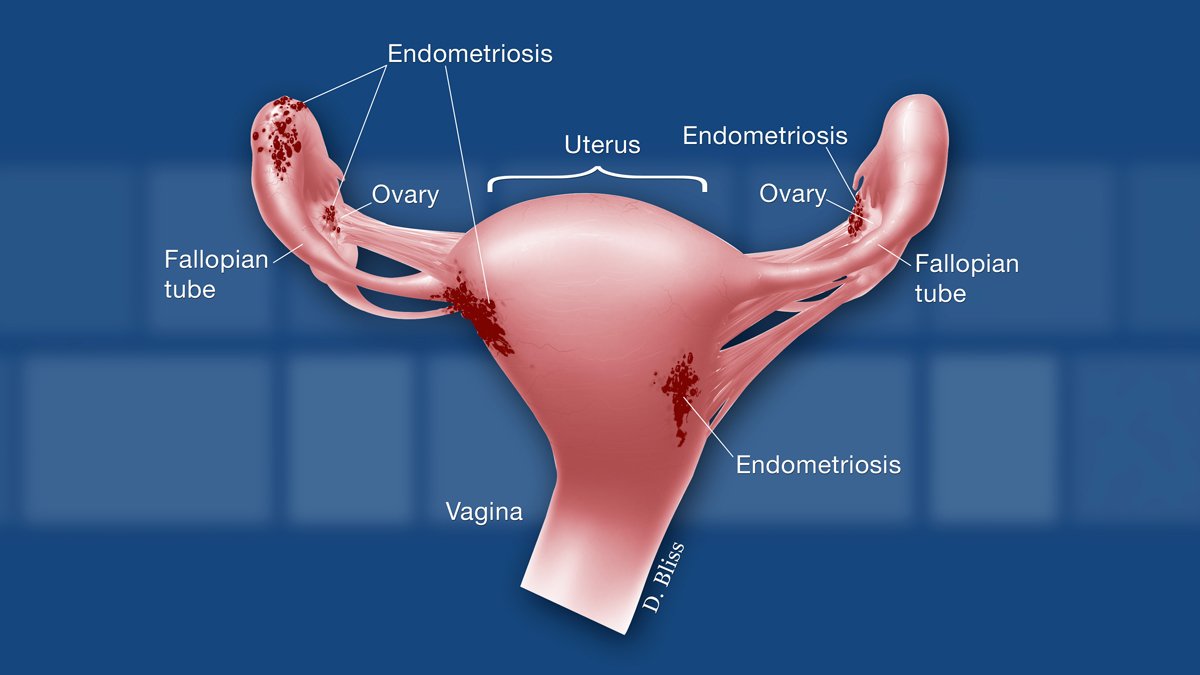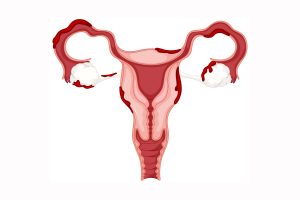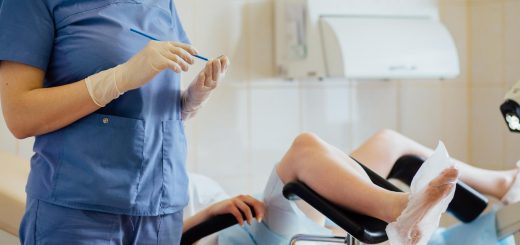Endometriosis of the uterus

Endometriosis is a pathological process in which tissue develops outside the uterus, which is similar in structure and function to the tissue of its mucous membrane (endometrium). The process can involve the pelvic organs (fallopian tubes, ovaries, ligamentous apparatus). It can also involve the organs of the abdominal cavity, bladder and even the lungs. In the absence of treatment for endometriosis of the uterus, partial destruction of the affected organs, metastasis to the vessels and surrounding tissues is possible.
Causes of endometriosis of the uterus
The endometrium is the lining that lines the interior of the uterus. Normally, its cells are removed every month during menstruation. However, in some cases, these cells remain in the body, most often getting into the fallopian tubes and ovaries with the blood flow. This process is called retrograde menstruation in medicine. In these organs, the endometrial cells become fixed and begin to develop independently2.
The resulting tissue is similar in structure to the endometrium. It also functions according to the menstrual cycle. The result can be serious violations of the functioning of the female genital organs, including infertility, cysts, disruptions in the menstrual cycle.
Disease 10 theories
In medicine, there is still no consensus about the causes of endometriosis. There are 10 theories of origin. Most scientists call it a consequence of systemic pathology resulting from dysregulation of immune and hormonal processes.
Risk factors
The transfer of endometrial cells from the uterus to various organs can occur due to stenosis of the cervix and other congenital obstructions in the outflow of blood from the uterine cavity. An increased risk of developing this disease is in women who have undergone operations related to the genitals: cesarean section, abortion, cauterization of erosions (diathermocoagulation). If these interventions occurred in the period before menstruation, the likelihood of the introduction of endometrial cells into other tissues increases.
Risk factors also include2:
stagnation in the uterus;
displacement of the uterus due to pressure from neighboring organs;
obstructed labor (for example, with manual removal of the placenta);
intense physical activity during menstruation;
neuropsychic stress during menstruation;
intercourse during menstruation;
menstrual irregularities.
The process can be triggered by inflammatory diseases of the genital organs: inflammation of the uterus and appendages, hyperplastic processes of the endometrium and ovaries, uterine fibroids. There is also an opinion that the late realization of reproductive function, that is, the birth of the first child at the age of 35-40 years, can serve as a risk factor. Many doctors attribute increased estrogen levels, metabolic disorders, obesity, immunosuppressive conditions, smoking, and alcohol abuse to risk factors.
5 facts about endometriosis
1. In the world, about 10% of women of reproductive age have endometriosis at the moment (estimates of the World Endometriosis Research Foundation).
2. Up to 50% of women of reproductive age are faced with this problem in one way or another (according to various researchers).
3. The average age of patients is 38–40 years, and in patients with ovarian cysts caused by this disease – 30 years.
4. Scientists do not attribute endometriosis to any of the pathological processes: neither to tumor growth, nor to inflammation, nor to pathological regeneration.
5. According to some scientists, up to 60% of patients who do not see a doctor on time face complications in the form of infertility.
Symptoms of uterine endometriosis in women
The disease is insidious in that in some patients it can pass completely asymptomatic, while in others it can manifest itself with sharp and sharp pains. The disease is characterized by a long and usually progressive course.
Professor of the Department of Obstetrics and Gynecology FPPOV First Moscow State Medical University named after THEM. Sechenova, Doctor of Medical Sciences Ara Leonidovich Hunanyan considers pain syndrome and infertility to be the main clinical manifestations.
Pain syndrome
During menstruation, the organs affected by endometriosis increase in size, due to which neighboring organs, tissues, and nerve endings are squeezed. Most patients experience pain:
during menstruation (dysmenorrhea);
during or after intercourse (dyspareunia);
during bowel movements (dyschezia).
In some cases, pain is localized in the pelvic region and is not associated with any physiological process.
Infertility
The problem manifests itself in 25-40% of patients. Infertility is of an unclear nature. Scientists associate it with changes in the fallopian tubes. The cause may be occlusion, that is, a violation of their lumen up to a complete blockage. A decrease in the functional activity of the fallopian tubes is possible due to a violation of their contractions.
Another reason is ovarian dysfunction, hormone production disorders. This can lead to an autoimmune reaction, which is expressed in the early termination of pregnancy.
The four main symptoms of uterine endometriosis
1. Pain in the premenstrual period and during menstruation. It can be clearly localized in one place or spread throughout the pelvis.
2. Infertility. Has a relative character.
3. Bloody spotting before and after menstruation. Sometimes possible in the middle of the cycle.
4. Prolonged menses with profuse blood loss. Lead to constant weakness, drowsiness, fatigue, dizziness.
Additionally, the disease can manifest itself in the form of sexual dysfunctions, psychoemotional disorders.
Classification
In medicine, this disease is usually classified according to the localization of the pathological process5.
Genital. The process develops in the internal and external genital organs (ovaries, uterus, fallopian tubes, cervix, vagina, labia).
Extragenital – in other organs and systems (intestines, peritoneum, kidneys, lungs).
Retrocervical is a rare form in which endometrial cells enter the sacro-uterine cavity.
Possible complications
The most common complication of an advanced disease is infertility1. According to various estimates, untreated endometriosis leads to this problem in 30-40% of cases. Infertility occurs due to a violation of the patency of the fallopian tubes. Less often – due to immune failures that lead to the destruction of eggs and sperm that enter the female body. There is a high risk of cysts in the ovaries that are filled with old menstrual blood.
When sprouting into other organs, the intestines and ureters are most often affected. The functioning of these organs is disrupted. Due to the narrowing of the ureter due to the proliferation of endometrioid tissue, urine cannot pass normally. Over time, hydronephrosis https://en.wikipedia.org/wiki/Hydronephrosis can form – a pathological change in kidney tissue. Adhesions and scars can form in the abdominal organs. If the sprouting compresses the nerve trunks, neurological disorders are possible.
Due to the fact that patients lose a lot of blood during menstruation, anemia may develop. It is expressed in pallor and yellowness of the skin, frequent dizziness, weakness.


